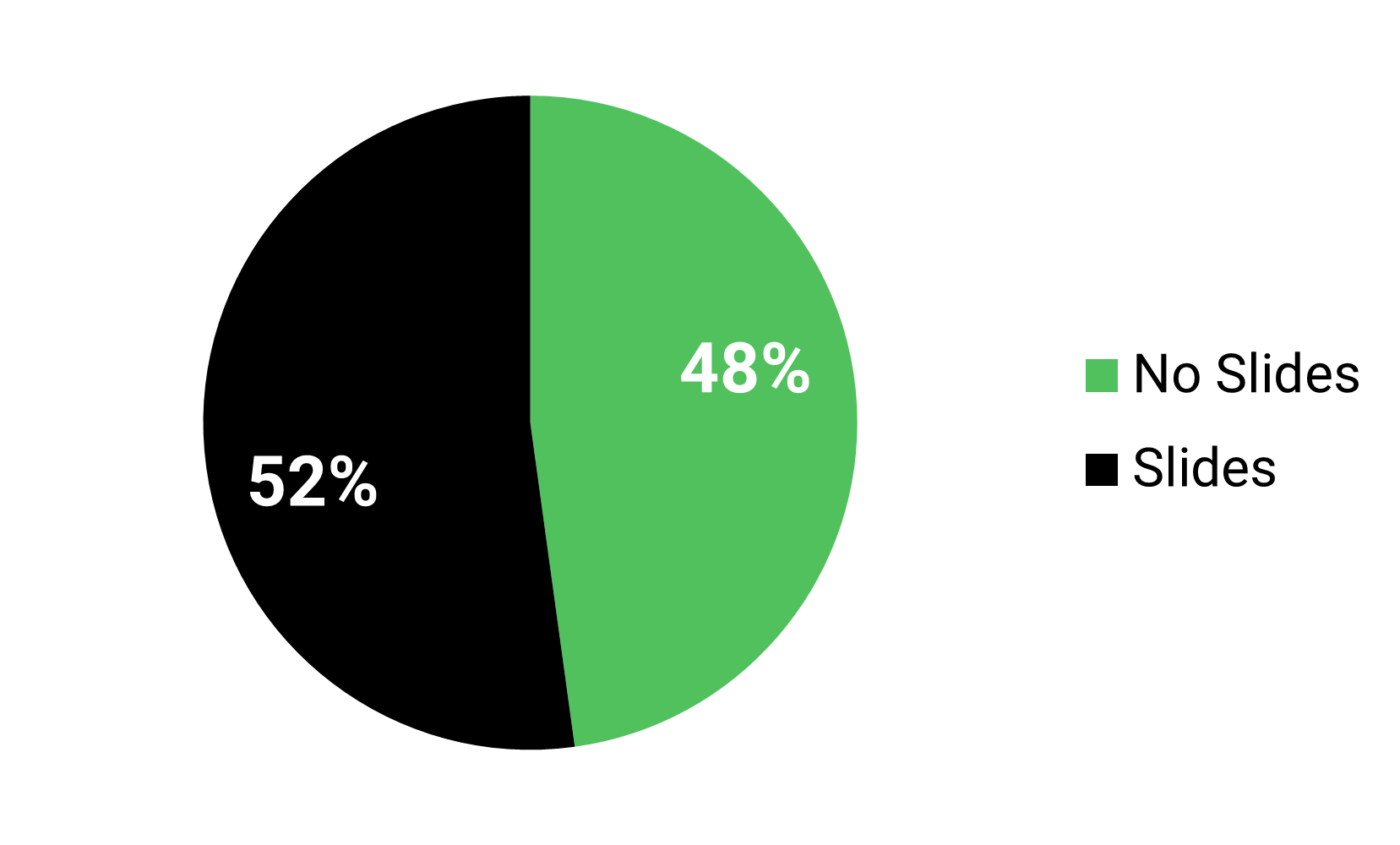Slide presentation or straight into a demo? Product specialists or account executives? 30 minutes or 60 minutes? PE Stack analyzes the approach of 50 sales teams we’ve engaged with alongside clients in the past year to bring you key insights from the world of SaaS demos and provide advice on how to get the most from your next product evaluation.
Introductions: Confirmation vs. Discovery
We found initial introductions lasted an average of four minutes before launching into a demo or slide deck. Cases where initial introductions extended significantly beyond average were universally because of an extended discovery session where vendors asked a lot of questions to learn about client background and requirements.
While establishing a common understanding between the two parties on basic requirements is key to an effective demo, there are ways to do this efficiently. PE Stack always provides detailed notes and background to vendors ahead of a call, and certain information about prospects is typically available online. Sessions that begin with vendors confirming their understanding of the client’s needs that allow the prospect to add detail and clarification before asking specific questions receive the most positive feedback.
The fact that most demos logged as running out of time at the scheduled finish had an above-average introduction time demonstrates the negative impact which poor preparation can cause.
Average Duration of Demo Introduction and Closing Phase by Demo Scheduled Length
PE Stack Advice
The most effective sales teams confirm and clarify their understanding of the prospect’s background and requirements, showing they are well-prepared and leaving their prospect confident about the future direction of the call. Asking discovery questions is of course fine, especially in cases where it's not possible to gather this ahead of time, but it can be frustrating for prospects when basic information is readily available online. Furthermore, in cases where clients (either directly or via a consultant like PE Stack) have taken the time to prepare requirements and these have obviously been ignored, this is never received well! We advise potential buyers to take the time to put together some background information and requirements ahead of booking demos to give sales teams the best opportunity of showcasing their product.
Death by PowerPoint?
A broadly even split of demonstrations relied on slides, with 48% of sessions we logged using a prepared slide deck - although it is noteworthy that presentations were rarer during 30-minute sessions. There was a significant duration range for this element of the call, with slides accounting for between 13% and 56% of the total time allocated. In our experience, lengthier presentations are not by design and are more often the result of questions that arise from prospects. While well-managed presentations can add value, including a slide deck certainly increases the likelihood of running out of time and must be managed effectively.
Proportion of Demos Incorporating a Slide Deck
Within our sample, 22% of demos that included slides were incomplete or ran over the allotted meeting time versus just 7% of demos that did not. Of course, the content contained within presentations is the key factor. The best presentations highlight elements of the company which cannot be shown during a demonstration, such as factors relating to the company, client base, and engineering capabilities.
Vendors get bonus points for tailoring this to the client—showing a logo sheet filled with similar firms to the prospect inspires more confidence than a generic listing. The presentations which leave us banging our heads on our desks are those which talk about the product we are about to see, leading to questions regarding functionality which are a waste of time given that we are about to see the product in question! These presentations leave prospects confused and should be avoided in our opinion; we’ve seen them kill the demo before it’s even started.
Time Spent on Slide Deck as a Proportion of Total Demo Length
PE Stack Advice
Presentations, when well-managed and ideally tailored to the client, can be an effective tool. Vendors should limit content to that which helps position the company and product, rather than covering product features. We feel that product questions are best tackled during the demonstration or in an allocated slot toward the end. Attempting to describe features when the product can be showcased instead is frankly a poor strategy. To be clear, we also see the client as playing a key part here. Our advice to those reviewing products would be to limit questions during the initial phases and maximize the opportunity to see the platform in question.
30 vs. 60 Minute Demos
With a few exceptions, demos arranged in this sector tend to last either 30 or 60 minutes, with the majority falling into the 60-minute bracket. When done well, the 30-minute demo can be especially impactful – an average of 80% of the 30-minute demo is spent showcasing the product compared with 62% for 60-minute demos.
We find that shorter demos work well with products which are conceptually less complex and solving for fewer use cases. However, managing time effectively is a major consideration, with shorter demos leaving less time for wrap-up and questions.
Showcasing the Product–Too Many Cooks?
Within this demo portion, we can broadly categorize the approaches we see as:
Account Executive drives the discussion and product demonstration (60% of demos)
Account Executive drives discussion and presentation; Product Specialist leads the demo (40% of demos)
In addition, we sometimes see senior management joining an initial call to add another perspective to the discussions:
Senior Management on call in addition to Account Executive, either with or without Product Specialist (15% of demos – excludes instances of Senior Management leading demos)
While different products may be better suited to different approaches, the experience we have from hundreds of demos is that the added benefit of multiple representatives can be quickly diluted without an effective understanding of who is doing what and discipline around sticking to these roles. The most common issue we see is Management speaking over Account Executives, even to the point of taking over the demo. This can have the unintended result of presenting the salesperson in a negative light, in addition to disrupting the flow of the demo and the attention of the prospect. However, when managed well, the presence of a senior exec can be very positive, especially when it comes to instilling the vision of the company and answering complex or conceptual questions. (It is also common to see senior management brought into follow-up talks which are not within the scope of this study.)
Reaction to the 60% of demos we tracked that employed an account executive to run the demo and discussions was generally positive. The one downside here can be an increased likelihood of not knowing the answer to a specific question which a product specialist may be better placed to respond.
When product specialists are being used, results tend to be mixed. It becomes very clear which Account Executives have taken the time to prepare the specialists to show a tailored demonstration vs those taking a more generic approach. When Account Executives are providing constant direction to a Product Specialist, we question the point in using them at all! Although, to be clear, when used correctly Specialists can create a very positive impression of the product.
As an interesting aside, we do not see any negative reaction when sales trainees are present on calls; on the contrary we feel that this creates a positive impression of the vendor’s growth and approach to getting new employees up to speed.
PE Stack Advice
Effective product demonstration tips could form the basis of an entirely separate article, so we won’t attempt to go into great depth here. That said, we will identify just a couple of key points which we see as especially important: There is a night and day difference between sales teams that have prepared and tailored a demo for the specific requirements the prospect has outlined and those seeking to wing it with a generic product demonstration. Potential clients viewing the product should not be afraid to interject and ensure certain features are covered and irrelevant features are not taking up too much time. This is especially important when seeking to create an 'apples to apples’ view between products and something PE Stack will always seek to do when we are working on procurement projects with clients. Demo teams with multiple participants should define their roles and stick to them. We recommend having Account Executives lead discussions and bring others in as required with interjections from other vendor participants to be avoided unless completely necessary – even if that includes Senior Management!
Let’s Wrap Up
As one would expect, 30-minute demos left less time for questions with an average of three minutes compared to an average of six minutes for 60-minute sessions. Well managed demonstrations tend to answer product questions throughout the session, but this final wrap-up is important for both sides of the table in terms of:
Establishing timeline and action points for following up
Providing and receiving initial reaction to the product – which in some cases allows for misconceptions to be immediately cleared up
PE Stack Advice
In addition to the obvious value in the points raised above, leaving a little time at the end can help prospects process information before moving to their next call. Cases where our clients have a hard stop and the demonstration is over-running can lead to major distraction during the closing stages with no time for important factors to digest as they immediately jump to the next Zoom call. We spend a lot of time clearing up client misconceptions resulting from demos ending abruptly - the human brain needs time to process!
Final Thoughts
The key themes identified throughout lead us to conclude that good planning and discipline lead to productive demonstrations. This is not simply a consideration for sales teams either – buyers that have a good understanding of their own requirements, are conscious of time, and are aiming to complete an apples-to-apples comparison of potential vendors in a structured fashion will get far more from reviewing products. PE Stack’s Procurement Support services are specifically designed to ensure an efficient and productive process. If you’d like to learn more, please contact us before you kick off your next search.
A note on methodology:
While our analysis is not attempting to achieve the level of academic research, we have been careful to avoid duplication where appropriate and ensure results are not skewed due to the over-representation of any of our vendor partners.
PROCUREMENT DOESN’T HAVE TO BE PAINFUL
We help LPs & GPs identify, qualify, and procure software, data, and technology solutions with our unique and comprehensive procurement as a service offering.
If you are thinking about your data and technology stack, we can help! Please leave your details below and we will be in touch.









